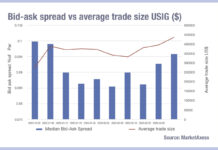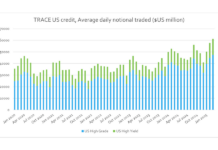By Flora McFarlane.
Sell-side bond trading is losing its lustre for traders, according to Greenwich Associates research. Increasing automation and regulatory changes may be the culprits.
When asked if they were to start their career again, would they go into bond trading, over half of sell-side bond dealers said ‘Definitely not’, with only 39% opting to stick with their original career choice.
 Author of the report, and head of market structure and technology research at Greenwich, Kevin McPartland said, “This negative sentiment toward bond dealing isn’t that surprising”.
Author of the report, and head of market structure and technology research at Greenwich, Kevin McPartland said, “This negative sentiment toward bond dealing isn’t that surprising”.
Attributing the decline in attraction of the bond market for professionals to increasing regulation, restrictive internal policies, changing technology and even the risk of criminal prosecution, the report painted an uninviting environment for sell-side dealers, and declining morale.
A recent Coalition report revealed that there has been a continual decline in headcount for FICC teams over the last five years, falling by a total of 28.5% from the first half of 2012 to H1 2017.
Equally firms have struggled to maintain revenues. This year, Q1 revenues across the major dealers grew 20% year on year (YoY), preceding a 16% drop in revenues in the second quarter. Key players such as Goldman Sachs and Morgan Stanley saw big losses, with decline in FICC Q2 revenues of 40% and 28%, respectively.
Speaking at Barclays Global Financial Service Conference on 12 September 2017, Harvey Schwartz, co-chief operating officer at Goldman Sachs compared the first half of 2017 versus the first half of 2016 and noted that activity declined in four of five client segments and the bank responded by adjusting its resources.
“We cut risk-weighted assets almost in half,” he said. “The ICS balance sheet down by more than 15%. FICC headcount declined by nearly 20% and FICC compensation benefits expense is down roughly 30%.”
The trend for banks looks set to continue, with Jamie Dimon, CEO of JP Morgan, recently forecasting a downturn of around 20% for Q3.
In a low rate environment fixed income investment is more challenging. That increases pressure on trading costs which will be further challenged under MiFID II’s best execution rules. Technology is being employed to help with investors utilising use new sources of data, get more colour on the market. However for dealers the increase in regulation is seen to be stifling their abilities to best serve clients.
“The overbearing regulatory environment negatively impacts our ability to service the best interest of clients”, said one respondent.
From an employment perspective, with sell-side brokers indicating an openness to moving to the buy side thanks to the opportunities for growth and “less stringent regulations”, the landscape of bond trading is evolving, requiring firms and professionals to work with the changes or move sectors.
McPartland highlighted the new norm for desks on Wall Street of “low-interest rates, no capital and greater electronic trading”, suggesting that the new generation of traders arriving will adapt to the increasing automation of the trading desk.
©TheDESK 2017
©Markets Media Europe 2025

























